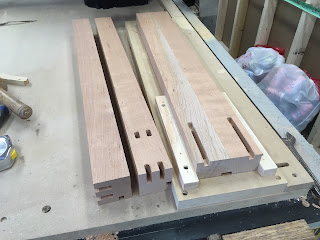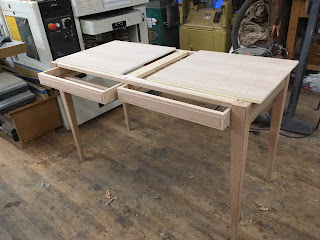above from the book 'the craftsman' by richard sennet
i've been catching up on my reading lately ...
click the photos to enlarge them
so, last week i had a small run of repairs,
bringing things back to useful life
i got the chair in the first photo above with the missing parts
in a nice cloth grocery bag .. first step was to reglue
the backsplat and get it ready to re install
here it is, all set to go ...
this was what i refer to as a 'functional restoration'
where the object is reassembled using the guide line
'if it doesn't make sense financially to fix it correctly. fix it any way you can'.
a 'proper' restoration was not financially feasible, yet the repairs
i did here will extend the chair's life, (barring catastrophe), for the foreseeable future.
and then something comes in the door that just blows you away
yowza!
details, detail, details ... nice black mother of pearl in the peacock's tail
and i love the details on the metalwork .. that alone probably took a couple of minutes
the client inherited this chest from her aunt who collected
chinese 'stuff' .... i can't imagine who commissioned this one ...
and let's not neglect the back ... i think they threw the
angles and curves in just for fun ...
another painted chest required some adjustment and repair to
the little stubby legs, which may or may not have been original ..
FUNKY CHAIR !! obviously a green wood construction
check the warp on that seat .. quite a twist!..

point of interest here, after cutting off the front leg a bit to relevel it,
i noticed that the leg was turned from what appears to be a branch, with
the heart included in the turning .. never saw that before .. my guess is circa 1800.
better view of the warped seat
note the fact that the left leg in the rear and the opposite leg in the front
were shortened by at least an inch each ..
were shortened by at least an inch each ..
and then we get to my friend Tom's 'music chair'
which he has been sitting in to play his guitar for a good portion of his recent life.
when it arrived, it had three snapped off tenons, one on the top of a leg, two stretcher ends,
and a long spit in the center stretcher ...
the leg top i was able to drill for a 5/8th" oak dowel new tenon, but the stretchers
required turned and scarfed on new tenons with small screws reinforcing the joints
from the bottom of the stretchers. tom's my age, the chair's quite a bit older,
and we'll see how it goes. i am hopeful ...
and below, from a previous restoration blog post i wrote a few years ago about repairs ..
that blog post has a link to a new yorker article on
the conservation studio at the new whitney museum ...
the new yorker article is a thought provoking read on art and time passing ...

which he has been sitting in to play his guitar for a good portion of his recent life.
when it arrived, it had three snapped off tenons, one on the top of a leg, two stretcher ends,
and a long spit in the center stretcher ...
the leg top i was able to drill for a 5/8th" oak dowel new tenon, but the stretchers
required turned and scarfed on new tenons with small screws reinforcing the joints
from the bottom of the stretchers. tom's my age, the chair's quite a bit older,
and we'll see how it goes. i am hopeful ...
and below, from a previous restoration blog post i wrote a few years ago about repairs ..
that blog post has a link to a new yorker article on
the conservation studio at the new whitney museum ...
the new yorker article is a thought provoking read on art and time passing ...











































